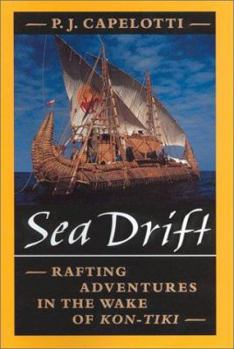Sea Drift: Rafting Adventures in the Wake of Kon-Tiki
Select Format
Select Condition 
Book Overview
It was the original Survivor series, only without the omnipresent cameras, paramedics, and faux tribal rituals. Between the spring of 1947 and the summer of the year 2000, more than forty expeditions... This description may be from another edition of this product.
Format:Hardcover
Language:English
ISBN:0813529786
ISBN13:9780813529783
Release Date:June 2001
Publisher:Rutgers University Press
Length:320 Pages
Weight:1.50 lbs.
Dimensions:1.1" x 6.4" x 9.6"
Customer Reviews
2 ratings
Modern attempts to mimic the adventures of the ancients
Published by Thriftbooks.com User , 16 years ago
How would ancient people have traveled across an ocean? Probably on structures made from obtainable vegetation that could float and could last for a while (and possibly on fast vessels). But what structures? Balsa wood rafts? Boats made from bamboo or cedar? Fairey Marine 505s? This book (with a mild pun for a title), by Peter Capelotti, tells of a wide variety of rafting expeditions, starting with the famous Kon-Tiki adventure of Thor Heyerdahl and his crew. And these attempts to cross the ocean, which were often successful, certainly were very exciting. But do they show that ancient people could have made such journeys as well? I think they do show it. The main problems that these adventurers faced were simple: loss of buoyancy (either from getting waterlogged or from destruction by teredo navalis worms), running out of food or water, threats of total destruction by occasional big storms, navigational failures (or worse, not having any idea where land might be even if they knew where they were), damage causing a loss of control of the boat, and risks in attempting to land (say on the weather side of a coral island). In my opinion, ancient people who were able to navigate up and down their coasts probably knew how to make boats that could survive for a few months. They also probably had a way to take enough food and water to last for that long. In addition, they had chances to catch fish, providing them with both food and water. By the way, Capelotti cites people who say that sea water can be added to fresh water in an emergency, but I think this is not a good plan. As for big storms, well, ocean travel can be dangerous. I know a number of people who have sailed across oceans (and even around the world) in relatively small boats (sometimes in ones they built themselves). But one such couple was unlucky and perished in a big storm. Similarly, many ancient people may have been lost in storms. On the other hand, there are ways of giving oneself better chances in storms. Some of these techniques are not all that new (John Voss and Norman Luxton, back in their 1901 voyage, knew plenty about them), and I suspect that ancient seagoing folks may have known some of these ideas as well. Perhaps they used sea anchors or drogues both to avoid being broadsided by waves and to try to calm the seas around their boats. Capelotti probably ought to have spent more time on some of the non-rafting adventures that are relevant to the ability of people to survive sea voyages in general. Of course, big storms are relatively infrequent. Not everyone gets caught in one, especially in just one trip across an ocean. By the way, I've crossed the Atlantic twice (in big passenger boats) and was in a huge storm on one of the trips but not on the other. In this book, we learn quite a bit about a number of different rafting expeditions. Heyerdahl's 1947 trip on a balsa wood raft and his later trips using reed boats. Alain Bombard's adventure o
Come drift with me.
Published by Thriftbooks.com User , 22 years ago
In 1947, Thor Heyerdahl set out in a raft he named Kon-Tiki from Peru and 101 days, and 4,300 miles later, slammed into a reef at Raroia in the Tuamotu Islands. This amazing voyage began a series of other rafting trips that, interestingly enough, continues up to the present day. P. J. Capelotti writes that in "1999, at least five different expeditions sought to sail on their reed or balsa-log rafts in search of answers to some perceived mysteries of prehistoric migration or navigation."Capelotti, who teaches archaeology and American Studies at Penn State University, Abington College, is an unabashed adventurer who, like many youths, fell in love with the idea of rafting like Heyerdahl and has "never lost my fascination with those who had the courage to embark" upon the voyages. Capelotti discusses the major voyages from 1947 to the present and there are some highly unusual trips. Santiago Genoves' 1973 sociological study aboard a raft with six women and five men surely must rank number one in strangeness. According to Capelotti, reading the study is "like a self-congratulatory cross between a letter to a pornographic magazine and the daily racing form."Readers who see a book published by Rutgers University Press, with an author who teaches in the academic world, may think they are going to find within the covers of Sea Drift a stuffy, footnoted tome. If so, they will have a very pleasant surprise. Capelotti does identify his sources, but his writing style is breezy and a pleasure to read. This book is a must read for anyone who ever thought they wanted to depart on an adventure--and who has not?




